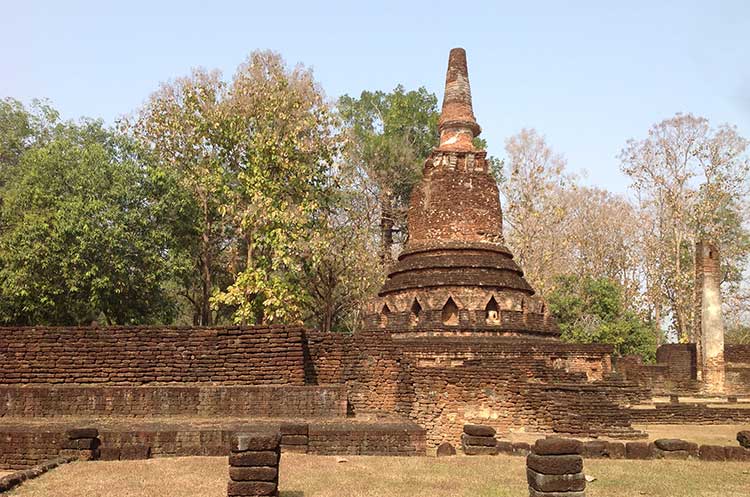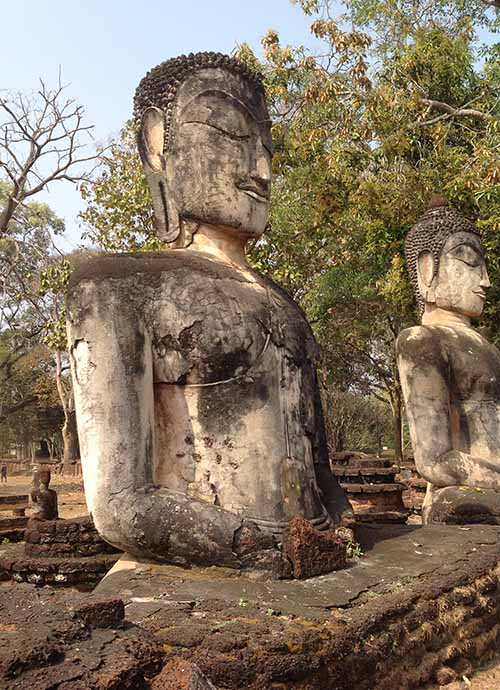
Wat Phra Kaew
Temple of the Emerald Buddha
The Wat Phra Kaew or “temple of the Emerald Buddha” is the largest temple of the central zone of Kamphaeng Phet Historical Park.
The 15th century temple was built in the center of the ancient walled town, parallel to the town wall and the Ping river. Located next to the Sa Mon, the Royal Palace of which nothing is left, the Wat Phra Kaew was a Royal temple where the King paid his respects to the Buddha.
The temple comprises only of a Buddhavasa area where all structures are dedicated to the veneration of the Buddha. As there were no resident monks living at the temple, there is no Sanghavasa area with the monks living quarters.
Two of Thailand’s most highly revered Buddha images
According to ancient chronicles, two of Thailand’s most highly revered images of the Buddha, the Phra Phuttha Sihing and the Phra Kaeo Morakot or Emerald Buddha were once enshrined in the Wat Phra Kaew. The temple got its name when King Mongkut visited the park halfway the 19th century and named the temple after the Emerald Buddha image.
Structures of the temple
Judging from the architectural style of its structures, archeologists believe that the temple complex was built over the course of several centuries. The temple’s main structures, a principal chedi, several viharns, two mondops and several dozen subsidiary chedis are aligned on an East West axis. A number of laterite Buddha images that still remain are badly eroded, of some only the outline remaining. The temple is enclosed by a wall of large blocks of laterite.
“Elephant encircled chedi”
In the West corner of the complex stands a large chedi which was enclosed by a gallery of which only the base remains. The chedi has collapsed, only its square base and the lower concentric rings are still standing.
Standing in niches around its base were 32 carved Sukhothai style elephant statues, their bodies protruding out from the structure. While most of the statues that seem to carry the chedi on their backs have gone, a few have been restored to their original glory. Most of these “elephant encircled chedis” were built during the Sukhothai era, other examples being the Wat Chang Lom and the Wat Sorasak in Sukhothai Historical Park.
The enclosing gallery is surrounded by subsidiary chedis in various styles and shapes, some octagonal, some with indented corners. East of the chedi was a large standing image of the Buddha known as Phra Attharot, of which only the feet remain. Behind the Phra Attharot image is the elevated base of a viharn. To its back is a large pedestal, on which a Buddha image was placed.
Viharn enshrining three large Ayutthaya era Buddha images
Another viharn enshrines three large very well preserved images of the Buddha. The three brick plastered images, one reclining and two seated in the Bhumisparsha mudra of “Calling the Earth to witness” were built during the Ayutthaya period. The large square foreheads and continuous eyebrows are typical for the Kamphaeng Phet style. Behind the images are small circular chedis and a rows of badly weathered seated Buddha images.

Principal bell shaped chedi
In front of the viharn are the remains of a mondop with a badly eroded laterite Buddha image in the Bhumisparsha mudra. The mondop faces the temple’s large, well preserved principal chedi. Around its square base, contained in 32 niches were statues of lions called “Singh” in Thai, of which very little remains. Enshrined in 16 niches in the circular tier above the base were seated images of the Buddha, most of which are missing. The chedi’s bell is topped with a tapering finial.
Huge elevated base supporting several structures
In the temple’s East corner stands a huge elevated laterite base, supporting several structures including the main viharn. To the back of the ubosot or ordination hall is a pedestal with a heavily eroded laterite Buddha image facing East. On the West end of the base is a structure with indented corners, believed to be a kind of Buddha throne, which once held the Emerald Buddha image.